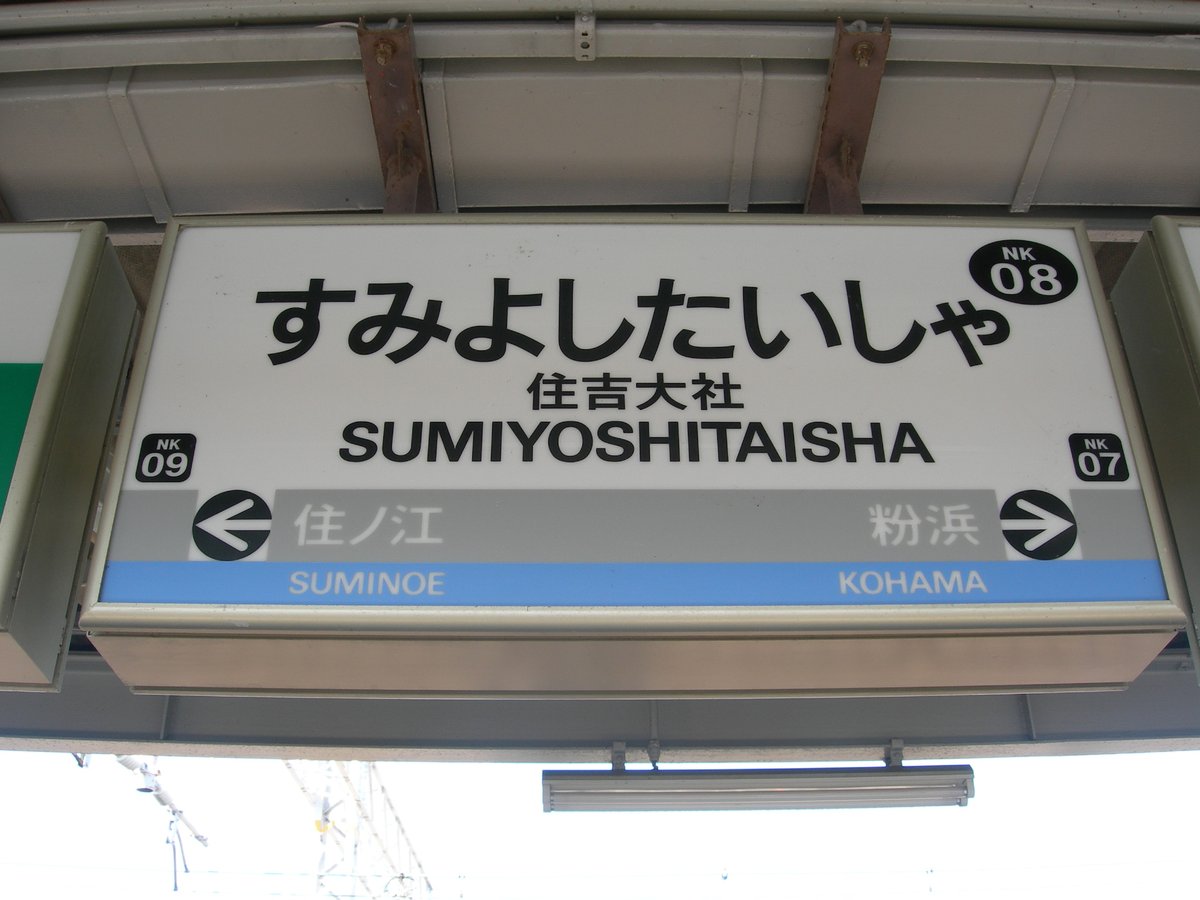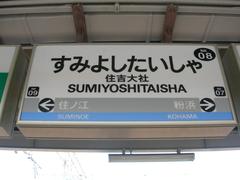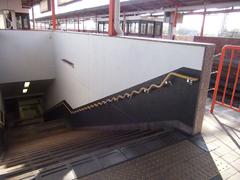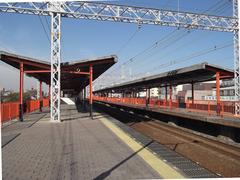
Sumiyoshitaisha Station: Visiting Hours, Tickets, and Nearby Attractions in Osaka
Date: 15/06/2025
Introduction
Sumiyoshitaisha Station (住吉大社駅) is the principal access point for visitors to Sumiyoshi Taisha, one of Japan’s most ancient and significant Shinto shrines. Located in Osaka’s Sumiyoshi Ward, this area is celebrated for its nearly 1,800-year history, distinctive maritime heritage, and unique Japanese architecture. The shrine, established in the early 3rd century by Empress-Regent Jingū, honors the Sumiyoshi Sanjin—deities revered as protectors of sea travel and commerce. Over the centuries, both the shrine and station have become essential to Osaka’s spiritual and cultural landscape (Sumiyoshi Taisha Official; Off the Track Japan).
This comprehensive guide provides detailed, practical information on visiting Sumiyoshitaisha Station and Sumiyoshi Taisha Shrine, including visiting hours, ticketing, accessibility, nearby attractions, and cultural highlights, ensuring a rewarding experience for every visitor.
Table of Contents
- Origins and Historical Development
- Architectural and Artistic Heritage
- Visiting Sumiyoshitaisha Station and Sumiyoshi Taisha Shrine
- Religious and Cultural Significance
- Practical Visitor Information
- FAQ
- Conclusion
- References and Further Reading
Origins and Historical Development
Sumiyoshitaisha Station is operated by the Nankai Electric Railway on the Nankai Main Line and serves as the modern gateway to an area imbued with nearly two millennia of history. Sumiyoshi Taisha Shrine, founded by Empress-Regent Jingū, sits near the original Osaka Bay coastline and was historically significant for maritime travelers and diplomatic missions from the 7th to the 9th centuries (Sumiyoshi Taisha Official; Off the Track Japan).
During the Edo period, Sumiyoshi flourished as a key stop on the Tokaido route between Kyoto and Edo, facilitating economic and cultural exchange (Osaka.com). Despite modernization and wartime challenges, the area retains its historical spirit, blending tradition with urban vibrancy.
Architectural and Artistic Heritage
Sumiyoshi Taisha is renowned for its Sumiyoshi-zukuri style—an indigenous form of shrine architecture predating continental Asian influence. The four main sanctuary halls, built in 1810 and designated as National Treasures, feature straight, unpainted wooden structures with gabled roofs, raised floors, and symbolic ornaments such as chigi and katsuogi (JW Web Magazine; Sumiyoshi Taisha Official).
A highlight is the Sorihashi (Taiko) Bridge, a steep, vermilion-lacquered arch that represents the transition from the secular world to sacred precincts (Kanpai Japan). The shrine grounds also include hundreds of stone lanterns, ancient trees, auxiliary shrines, and a traditional Japanese garden with tranquil ponds and sanded courtyards, all designed for ritual processions and seasonal celebrations.
Visiting Sumiyoshitaisha Station and Sumiyoshi Taisha Shrine
Visiting Hours
- Sumiyoshi Taisha Shrine: Open daily from 6:00 AM to 5:00 PM (hours may be extended during special events or festivals).
- Sumiyoshitaisha Station: Operates from around 5:00 AM to midnight in line with Nankai Electric Railway schedules (Osaka Station Guide; Kansai-Chan Guide).
Tickets and Access
- Station Tickets: Purchase tickets at station counters or automated machines. IC cards like ICOCA and PiTaPa are accepted for easy travel.
- Shrine Admission: Entry to the shrine grounds is free. Some special exhibitions or guided tours may require a separate fee (Sumiyoshi Taisha Official).
Accessibility
- Elevators, ramps, and accessible restrooms are available at both the station and shrine. The paved path from the station to the shrine is wheelchair-friendly.
- For visitors with disabilities, assistance can be arranged by contacting the shrine or station in advance (Sumiyoshi Taisha Accessibility).
Travel Tips
- Visit early in the morning or on weekdays for a quieter experience, especially outside major festivals like Hatsumōde (New Year) and Sumiyoshi Matsuri (late July).
- Consider booking a guided tour for deeper insights into the shrine’s history and rituals. Local agencies and the shrine’s visitor center offer English-speaking guides.
- During peak festival periods, anticipate larger crowds and plan accordingly (Japan Food Guide).
Nearby Attractions
- Sumiyoshi Park: Osaka’s oldest public park, ideal for walks and picnics, especially during cherry blossom and autumn foliage seasons (Osaka Info).
- Osaka Bay Area: A short train ride brings you to the Osaka Aquarium Kaiyukan, Tempozan Ferris Wheel, and shopping at Tempozan Marketplace (5c5g.net).
- Namba Yasaka Shrine: Known for its giant lion-head stage, accessible via the Nankai Main Line.
- Shinsekai and Tsutenkaku Tower: Retro district with local street food and panoramic city views (matcha-jp.com).
- Osaka Castle Park: Explore the iconic castle and surrounding gardens, about 30 minutes by train.
- Minoh Park: Enjoy scenic trails and waterfalls, ideal for a nature escape (jw-webmagazine.com).
Religious and Cultural Significance
Sumiyoshi Taisha Shrine enshrines the Sumiyoshi Sanjin, protectors of sailors and travelers, and is deeply woven into Osaka’s maritime history. The shrine’s unique architecture and spiritual legacy have inspired poetry, art, and community life for centuries (Sumiyoshi Taisha Official; Osaka Info).
Festivals and Events
- Hatsumōde (New Year): Over 2 million visitors arrive in the first three days of January, making it one of Japan’s busiest shrines for New Year prayers.
- Sumiyoshi Matsuri (July 30–August 1): Features grand purification rituals, mikoshi processions, and traditional performances, attracting hundreds of thousands (Japan Food Guide).
- Otaue Shinji (June): Sacred rice-planting festival, recognized as an Important Intangible Folk Cultural Property.
- Other Rituals: Includes Unoha Shinji (Rabbit Flower Rite), Tōka Shinji (Plum Branch Ritual), and Ao-uma Shinji (White Horse Ritual), each rich in symbolism and tradition (Sumiyoshi Taisha Official).
Practical Visitor Information
Transportation
- By Train: Take the Nankai Main Line from Namba (about 10 minutes) or Shin-Imamiya, or use the Hankai Tramway for a nostalgic ride (Kansai-Chan Guide).
- By Bus: Multiple city buses serve the Sumiyoshi area.
- By Taxi or Car: Limited parking is available; taxis are a convenient option for groups or those with mobility needs (TravelSetu).
- On Foot: The area is walkable, especially pleasant during cherry blossom season.
Facilities
- Luggage Storage: Coin lockers are available at the station; larger luggage can be stored at major stations like Namba.
- Restrooms and Amenities: Accessible restrooms, convenience stores, and eateries are nearby.
- Barrier-Free Access: Both the station and shrine offer barrier-free facilities.
Peak Times and Crowd Management
- Expect significant crowds during New Year’s and Sumiyoshi Matsuri. Special train schedules and additional staff help manage the flow (Osaka Station Guide).
Etiquette
- Purify hands and mouth at the temizuya before worship.
- Bow before passing through the torii gate.
- Maintain quiet and respectful behavior, especially during ceremonies.
- Photography is allowed except during rituals or in restricted areas.
Safety and Language Support
- Most signage is bilingual (Japanese/English); staff at major stations and tourist centers can assist English-speaking visitors.
- Emergency numbers: 110 (police), 119 (ambulance).
FAQ
Q: What are the visiting hours of Sumiyoshi Taisha Shrine?
A: Daily from 6:00 AM to 5:00 PM (seasonal variations possible).
Q: Is there an entrance fee to the shrine?
A: Admission to the main grounds is free. Certain events or guided tours may have fees.
Q: How do I get tickets at Sumiyoshitaisha Station?
A: Tickets are available at counters and machines; IC cards like ICOCA and PiTaPa are accepted.
Q: Is the shrine accessible for wheelchair users?
A: Yes, the main paths and facilities are barrier-free, though some areas may have steps or gravel.
Q: Are guided tours available?
A: Yes, particularly during festivals; inquire at the shrine or local agencies for details.
Q: What are some nearby attractions?
A: Sumiyoshi Park, Osaka Bay Area, Namba Yasaka Shrine, Shinsekai, Osaka Castle, and Minoh Park.
Q: When is the best time to visit?
A: Spring (cherry blossoms), summer (festivals), and autumn (foliage) are the most scenic seasons.
Conclusion
Sumiyoshitaisha Station and Sumiyoshi Taisha Shrine together offer a seamless blend of accessibility, historical depth, and spiritual resonance. From its iconic Sumiyoshi-zukuri architecture and ceremonial Sorihashi Bridge to vibrant festivals and tranquil gardens, the site is a living testament to Osaka’s enduring cultural heritage. With convenient transport links, free shrine admission, and modern visitor amenities, every traveler can enjoy a meaningful encounter with Japan’s Shinto traditions.
For the latest information, real-time navigation, and insider tips, download the Audiala app. Explore further Osaka travel guides on our website and follow us on social media for event updates and cultural inspiration.
References and Further Reading
- Sumiyoshi Taisha Official
- Off the Track Japan
- JW Web Magazine
- Osaka.com
- Kanpai Japan
- Japan Travel
- Osaka Station Guide
- Kansai-Chan Guide
- Japan Food Guide
- jw-webmagazine.com
- 5c5g.net









































































